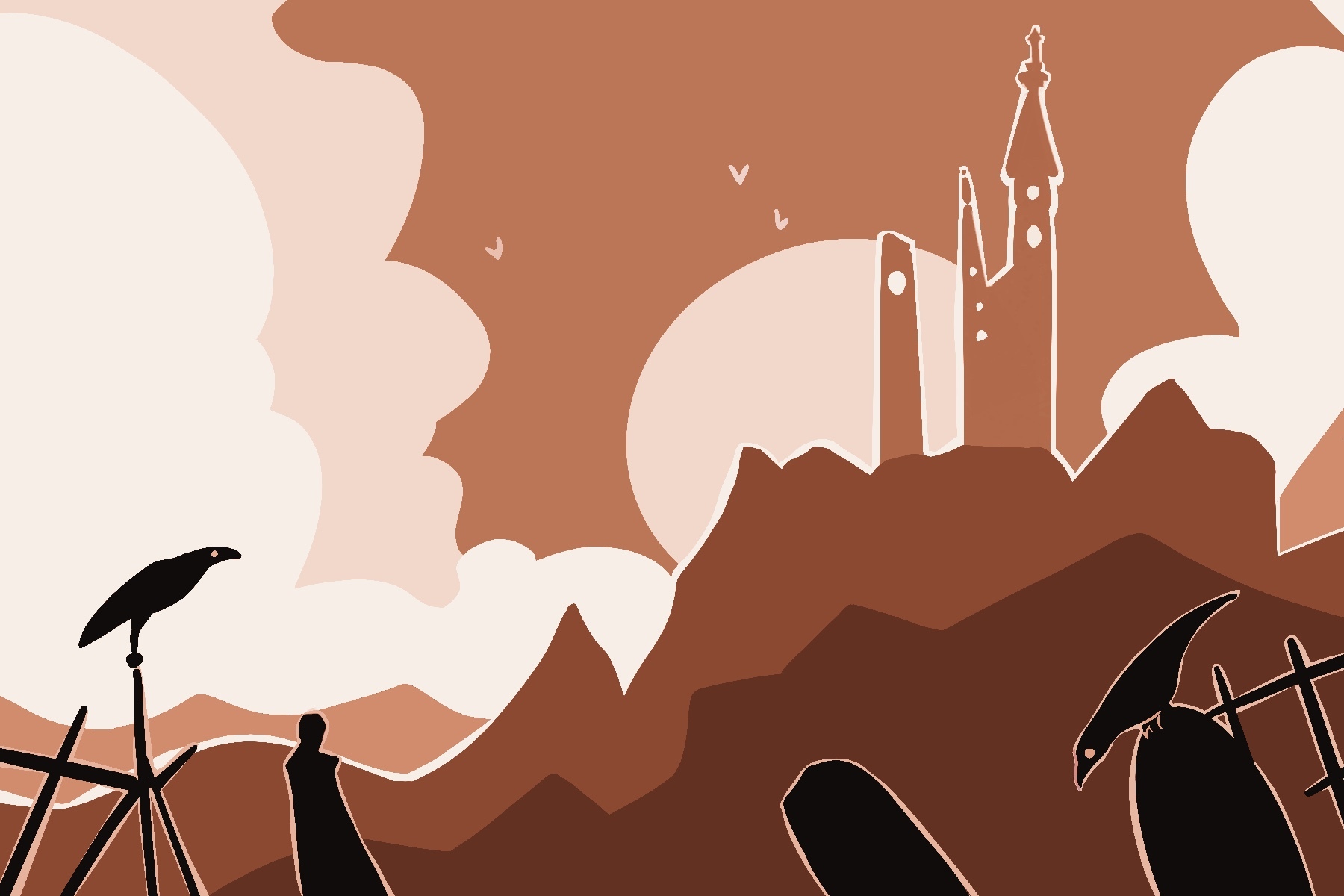The aesthetics of gothic horror are well-known in the media. One might think of old ancestral homes, terrible storms and ladies wearing long, white nightgowns when they hear the word “gothic.” Works in the genre such as “The Castle of Otranto” and “Mexican Gothic” do use these elements; both the castle and the High Place are plagued by ghosts, bad weather and curses. Their aesthetics set them apart from other types of horror, but simply having these images does not make a work gothic. The gothic horror genre is also defined by its transgression, its inclusion of the sublime, its distinction between terror and horror, its archetypal characters and its examination of contemporary anxieties.
Horace Walpole’s “The Castle of Otranto” was published in 1764 and is considered to be the first gothic work. The novel follows Prince Manfred’s desperation to avoid a prophecy that predicted the castle of Otranto would pass from his family line into other hands. Walpole codified many tropes and themes of gothic horror, including supernatural elements, prophecies, ancestral homes and a remote setting. There are talking portraits, walking suits of armor, the aforementioned prophecy and the old castle itself. Though the novel was written in the late 1700s, it takes place around the time of the Crusades. And, though it was written by an Englishman, it takes place in Italy.
Walpole’s work especially used the idea of transgression. In his desperation to avoid the prophecy coming to fruition, Manfred commits several transgressions against his family. He doesn’t show much grief when his only son, Conrad, dies. Instead, he plans to marry Conrad’s betrothed, Isabella, to carry on the family line. In doing so, he commits a sort of pseudo-incest. Isabella flees and Manfred pursues her. Manfred demands that his current wife, Hippolita, divorce him. Manfred’s sins culminate in the murder of his daughter Matilda, leaving him with no more heirs. Because of Manfred’s transgressive actions, the prophecy comes true and the castle is passed on to Theodore, a former peasant in the village turned rightful heir of the castle.
Mary Shelley’s “Frankenstein” contains one of the most well-known transgressions in literature. Victor Frankenstein goes against the laws of nature and ethical science when he plays God and brings his creature to life. As the novel continues, Frankenstein keeps transgressing by refusing to take responsibility. His actions lead to the deaths of his brother, his family’s housekeeper, his best friend and finally his cousin. Like Manfred, Frankenstein succumbs to the consequences of his actions by the end of the novel. If Victor Frankenstein had taken responsibility for his creation rather than fleeing in fear and abandoning it, nobody would have died.
“Frankenstein” also provides several examples of the sublime. In gothic horror, the sublime is the part of nature that inspires both awe and terror. When Frankenstein retreats into nature with his friend, he feels his spirits lift. He seeks out nature to “forget [him]self and [his] ephemeral, because human, sorrows.” This part of the novel shows the awe-inspiring side of the sublime. The terrifying side of the sublime is seen at the end, when Frankenstein pursues the creature up into the barren Arctic. The frozen land is far more powerful than any of the characters, and when Frankenstein finally dies of cold and exhaustion, it is implied that the creature is not far behind him.
The gothic horror genre also distinguishes between terror and horror. Anne Radcliffe, a pioneer in gothic romance, defined the two terms. Radcliffe wrote many gothic tales, including “The Mysteries of Udolpho” and “The Italian.” “The Mysteries of Udolpho” inspired M.G. Lewis to write his incredibly lurid novel, “The Monk.” In response to this, Radcliffe penned “The Italian.” The difference between these gothic horror novels shows the difference between terror and horror. Terror can be seen in Ellena’s plight in “The Italian,” as she is kidnapped and uncertain of who she can trust. Horror is seen in the graphic details of “The Monk,” especially in the titular Monk’s assault on a young woman. In Radcliffe’s words, terror “expands the soul” while horror “contracts, freezes and nearly annihilates” it. What sets the gothic apart from other horror genres is that it leans more toward terror than horror. While a slasher flick sets out to get a physical reaction from the audience, gothic horror aims to affect the audience emotionally and psychologically.
Archetypes are also very important to gothic works. The most common are the damsel in distress, the tyrant and the hero. These roles are seen in Isabella, Manfred and the rightful heir Theodore in “The Castle of Otranto.” In a few gothic texts, these roles are subverted slightly. For example, in Wilkie Collins’ “The Woman in White,” strong-willed Marian Halcombe acts as her sister’s protector when the hero of the story, Walter Hartright, is unable to. In Bram Stoker’s “Dracula” Mina Harker plays a pivotal role in ending Count Dracula’s terror. Even after she is assaulted by him, she is able to see into his mind to detect where he is heading, thus showing the heroes of the story where to find him. On the whole, however, the male heroes are typically the ones who stop the tyrant.
Gothic horror also grapples with the anxieties of a given time. “The Woman in White,” for example, is infused with mid-Victorian anxieties about insane asylums. In the novel, a woman is wrongly held captive in an insane asylum and is only able to escape with help. “Frankenstein” was written during a time of scientific advancement and explores how far the limits of science could go. Galvanism was an idea that theorized life could be brought back with electricity. The idea came from an Italian doctor’s experiment in which he made a frog’s legs twitch with small electric charges. Though we know about electricity today, “Frankenstein” remains timeless because it can apply to many time periods. The advent of AI and advanced technology is anxiety-inducing for many, and it’s important to be reminded of humanity’s limits.
While some anxieties are timeless, others unfortunately carry the baggage of the time in which they were written. One of the villains of “The Woman in White” is Count Fosco, an Italian. His foreignness makes him threatening. Another foreign tyrant is Count Dracula, who comes to England intending to take over the country. Some cultural anxieties in gothic works carry an unfortunate undercurrent of xenophobia.
Newer gothic works use many of these elements while adapting others to the modern day. One example of this is Helen Oyeyemi’s “White Is for Witching.” “White Is for Witching” uses the theme of transgression in an interesting way. Miranda Silver, the protagonist, has a condition called pica. Her mother and grandmother were also afflicted by the condition and were driven to eat inedible things such as chalk, acorns or blood. The house the Silver family lives in, 29 Barton Road, is haunted. It is also xenophobic; it drives out the foreign servants. It tries to kill Sade and Miranda’s college friend, Ore, because it feels threatened by them. 29 Barton Road is not only haunted, it is sentient. In the end, it succeeds in keeping Miranda trapped inside its walls. The anxieties present in this book come from the treatment of foreigners and immigrants, rather than the fear of them.
Sylvia Moreno-Garcia’s “Mexican Gothic” is another example of a newer work that features a haunted family estate, transgression and a remote setting. The novel takes place in the 1950s in Mexico. The protagonist, Noemi Taboada, leaves the city she’s familiar with for the countryside. Noemi’s goal is to check up on her cousin Catalina after receiving a strange letter from her. Virgil Doyle, Catalina’s husband, is heir to the High Place. The High Place is an English-style mansion constantly shrouded in a strange fog, which puts it at odds with the small village it overlooks. The Doyle family goes against nature with the oddness of their estate and commits a transgression against humanity with their history of colonialism. Noemi, as a Mexican, is treated like an outsider. The patriarchs, Howard and Virgil, discuss eugenics in front of her. In spite of this, Noemi is able to use her wit to get herself and Catalina out of the High Place. She is able to seek help from the village and discusses her plans in Spanish, preventing the Doyles and the house from foiling them. In this way, “Mexican Gothic” is a classically gothic novel while also featuring a female hero and addressing a problematic history of colonialism.

















